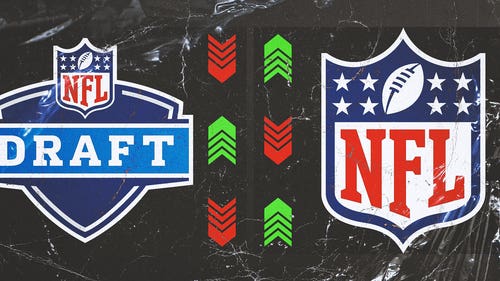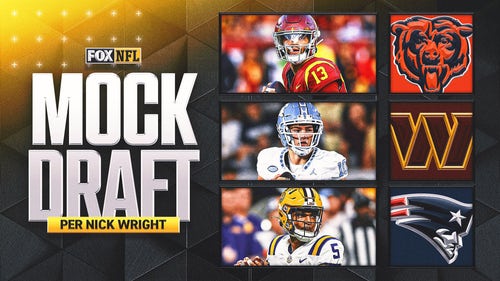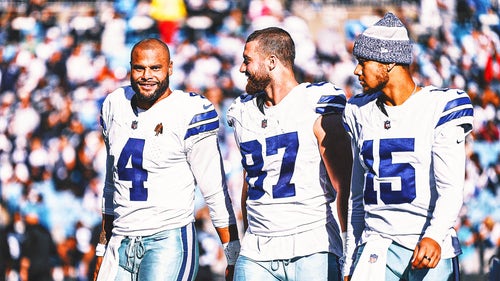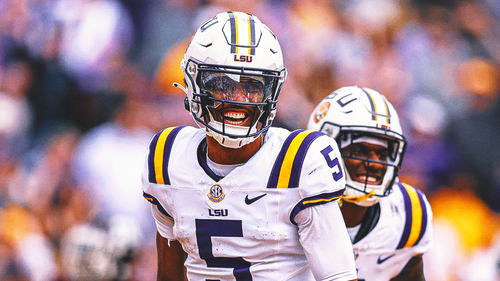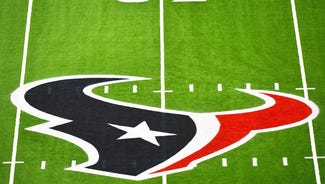
How the 49ers and Ravens got here
Twelve months after the San Francisco 49ers and Baltimore Ravens each came one game short of playing in Super Bowl XLVI, they’ll be going at it in Super Bowl XLVII. It’s easy to make this game about two men, brothers separated by a mere 15 months, but it’s really about two franchises and the long and winding roads both clubs have taken to get where they are today.
These Super Bowl runs didn’t start on a rainy afternoon in Candlestick Park or in the fog of Gillette Stadium, where the 49ers and Ravens lost their respective championship games a season ago.
They began long before last January.
Let’s break down how both teams — from front office decisions to courageous coaching choices to unlikely heroes — got to the Big Easy.
Baltimore Ravens
The Head Coaching Hire: Though it seems like ancient history now, Jason Garrett actually turned down the Ravens’ head coaching job in the winter of 2008. Garrett, who has since been stripped of his play-calling duties in Dallas, declined an offer so he could be the “coach in waiting” for the Cowboys under Wade Phillips.
Do you think Ravens fans are upset how that one turned out? Garrett’s never won a playoff game as head coach of the Cowboys. Harbaugh’s won eight.
Ravens owner Steve Bisciotti and the Baltimore front office took a roll of the dice in 2008, going with a lesser known assistant coach for the head job, giving John Harbaugh the rare opportunity to jump from special teams coach to head coach. It’s worked out beautifully. Not only have the Ravens made the playoffs and won at least one postseason game in all five seasons Harbaugh’s called the shots, but some big veteran personalities have taken to him in an unbelievable way.
Make no mistake, when you’re a first-time head coach, it’s not easy walking into a locker room that already has vocal leaders like Derrick Mason,Terrell Suggs, Ray Lewis and Ed Reed. Harbaugh quickly earned those players’ respect and now he has the last three just one win away from the Lombardi Trophy.
The Big Front Office Hire: General Manager Ozzie Newsome gets plenty of media attention and it’s all well-deserved, but Eric DeCosta — Baltimore’s assistant general manager — is right up there with Newsome on the list of the most respected front office minds in the NFL. He’s been with the Ravens all 17 years they’ve been an NFL organization, meaning he’s played a role in drafting everyone from Ray Lewis and Jonathan Ogden to recent late-round gems like Dennis Pitta and Bernard Pierce. With many suitors calling his name last January, owner Steve Bisciotti stepped up to the plate and made sure he locked up DeCosta long-term, raising his salary and making him one of the highest-paid executives in the league. Don’t expect a drop-off when Ozzie Newsome finally does call it quits. DeCosta’s more than just a “GM in waiting”; he’s the real deal.
The Draft Haul: Truthfully, the Ravens have been hitting home runs in the NFL Draft since 1996. You look at the bulk of their big stars, and they’re mostly all “home grown” talent. Ray Lewis (1996), Ed Reed (2002), Terrell Suggs (2003), Marshal Yanda (2007), Ray Rice and Joe Flacco (2008), Lardarius Webb and Paul Kruger (2009), Dennis Pitta (2010), Torrey Smith (2011), and Courtney Upshaw, Kelechi Osemele, and Bernard Pierce (2012) have all been slam dunks. Amazingly, that’s only scratching the surface. There have been very few swings and misses, with the exception of perhaps Kyle Boller, in Baltimore’s recent draft history.
The Big Acquisition: The Ravens always had a sound running attack and a reliable defense, but the passing game really got over the hump when Baltimore went out and finally acquired a big name receiver. That man was Anquan Boldin. Traded from Arizona in 2010 for third, fourth, and fifth-round picks, Boldin’s been everything the Ravens hoped for and more. Big, tough, and physical, he’s the perfect complement to 2011 first round pick Torrey Smith. Bringing Boldin in (and paying him $28 million over four years) wasn’t roundly applauded by the pundits, but the trade (and the hefty price tag that came with it) has proven to work out just fine. Boldin has saved his best for last, having huge games against both the Colts and Patriots in the playoffs. Since joining the Ravens in 2010, no player has totaled more receiving yards in the postseason (512) than Q.
The Bold Midseason Move: Cam Cameron was a member of the Baltimore Ravens coaching staff since 2008. A day after the Ravens clinched the AFC North division title, Harbaugh fired his longtime friend and offensive coordinator. "Cam is my friend, he taught me a lot about coaching, and he is an outstanding coach," Harbaugh said in a statement that afternoon.
"It's not about fair or unfair, right or wrong," the statement continued. "My responsibility is to the whole team and what's best for them right now. We need a change." The move raised eyebrows across the league. Guess what? With Jim Caldwell calling the plays, the offense has flourished. Joe Flacco hasn’t thrown an interception since his pick-6 against the Broncos in Week 15. Firing a dear friend probably wasn’t easy — especially when Baltimore had already secured a playoff berth — but Harbaugh did what he felt he had to do. It has worked out.
The Unsung Heroes: It’s rare you see a team shuffle its entire offensive line during the middle of an NFL season. It’s unprecedented to make such a move prior to the start of the playoffs. That’s just what John Harbaugh did before the wild card round, inserting veteran Bryant McKinnie at left offensive tackle, moving Michael Oher to right tackle, and sliding rookie Kelechi Osemele to left guard.
With the offensive line clicking, the Ravens had 356 yards of total offense and held a three-minute advantage in time of possession in their AFC Championship Game win over the Patriots. Joe Flacco’s been sacked just four times in the postseason. The offensive line hasn’t gotten the press that it deserves.
The Low Point: The low point of the Ravens season came in Week 15, when they trailed 31-3 to the Broncos at home. In Jim Caldwell’s first game calling the offensive plays, Baltimore's offense sputtered in the first half, gaining only 119 yards and committing two turnovers that led to 10 Denver points. The Ravens lost their third in a row at home that day. At that point, down 28 points with most of the crowd already long gone, it was awfully hard to ever imagine a Super Bowl trip to New Orleans six weeks later.
The Play of the Year: Jacoby Jones. 70 yards. This can’t be argued.
San Francisco 49ers
The Head Coaching Hire: The hiring of Jim Harbaugh got a lot more national attention than the hiring of John Harbaugh. After putting San Diego back on the map and rebuilding Stanford back into a national power in the college ranks, Harbaugh was courted by multiple teams, most prominently the Miami Dolphins. Dolphins owner Stephen Ross — like Harbaugh, a University of Michigan alum — reportedly offered Harbaugh a deal in the $7-8 million range to become Miami’s new head coach in January, 2011. Harbaugh never accepted the offer, he was hired by the 49ers shortly thereafter, and the two franchises have gone in two very different the past two seasons.
The Big Front Office Hire: Though he’d been with the organization in some capacity since 2004, some outside of San Francisco were surprised when the 49ers hired Trent Baalke over Michael Lombardi when the general manager position was being filled. A first-year GM, Baalke assumed the title in January and got right to work, hiring Jim Harbaugh as the team’s new head coach and laying the groundwork for an NFL Draft that would eventually bring Aldon Smith, Colin Kaepernick and Kendall Hunter to San Francisco. Coming off of a lockout-shortened offseason in which personnel moves were extremely unique, Balke won the PFWA’s Executive of the Year award in January, 2012. That’s the front office equivalent of being the MVP and the Rookie of the Year in the same season. Along with Tom Gamble, the 49ers director of player personnel, Baalke has built a deep roster, rich with veteran and young talent at just about every position. You might not be able to spot Baalke in a crowd. That’s fine. He’s the man behind the scenes who’s been making all the right moves for two years now.
The Draft Haul: Though he wasn’t the general manager, folks within the 49ers organization all credit Baalke for running the San Francisco draft war room in 2010. That draft brought the 49ers three stars in Anthony Davis (11th overall), Mike Iupati (17th overall), and NoVorro Bowman (third round). 2011 brought Aldon Smith, Colin Kaepernick, Chris Culliver, Kendall Hunter and Bruce Miller. Though 2012 has only seen one draft pick (LaMichael James) play much of a role on either side of the ball, there’s optimism that first-round pick, receiver A.J. Jenkins, develops into a ballplayer in his sophomore season.
The Big Acquisition: This one pre-dates the Harbaugh era, but there was no more important free agent acquisition in recent 49ers history than the signing of Justin Smith in 2008. Left with a void on the defensive line when Bryant Young retired after the ’07 season, the 49ers inked Smith to a six-year, $45 million contract that included $20 million in guarantees. They got Smith to sign on the dotted line after taking him on a helicopter tour of San Francisco. Five years later, he’s widely considered the most valuable player in the 49ers locker room. He’s worth every penny of that deal … and the helicopter rental.
The Bold Midseason Move: This may sound like hyperbole, but I’m not sure there’s been a bolder midseason player personnel move in recent NFL history (italics) than Harbaugh going with Colin Kaepernick over a healthy Alex Smith at quarterback. It’s the move that everyone (well, mostly everyone) second-guessed. It’s the move that has the 49ers in the Super Bowl.
The Unsung Heroes: Harbaugh gets a lot of the attention, but his offensive and defensive coordinators, Greg Roman and Vic Fangio, deserve plenty of credit, too. Brought with him from Stanford, both coaches came and implemented offensive and defensive schemes built around the talent at their disposal. With Alex Smith, the 49ers ran a certain offense. With Colin Kaepernick, they run an entirely different one. Fangio brought his 3-4 defense, made an already strong front seven stronger, and has put his stamp on the unit. These guys were coaching in the Pac-10 two years ago. Now, all three are on the biggest of stages in the pros.
The Low Point: After outscoring the Bills and Jets by a combined 79-3 in consecutive weeks, the 49ers were blown out by the Giants 26-3 in Candlestick Park back in Week 6. Alex Smith reverted back to the Alex Smith of old, and it appeared as though the Giants — the defending conference champions — had the 49ers number. After falling behind early, the offense didn’t have enough firepower to mount any sort of comeback. Questions about the quarterback — despite dominant back-to-back weeks — began to resurface.
The Play of the Year: Kaepernick’s back-breaking 56-yard touchdown run against the Packers in the divisional round can’t be topped. That play, alone, is still giving Green Bay defensive coordinator Dom Capers nightmares.
Two teams. Two very different roads to New Orleans. The journey, of course, is far from finished for both.








































































































































